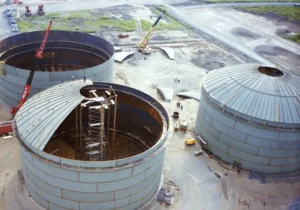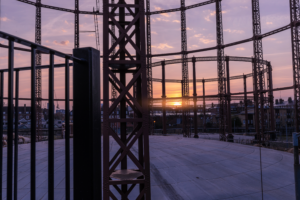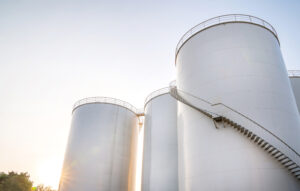The experts at Paresa explain how its holistic approach is advancing roof air raising through technical precision
Roof Air Raising (RAR), is a long-standing standard technique in atmospheric and cryogenic storage tank construction. However, Paresa, through its subsidiary Sonningdale Tank Services, is looking to shake up the game by incorporating meticulous planning, stakeholder collaboration, and commitment to safety and reliability. Rather than relying solely on technological innovation, Paresa’s methodology integrates technical expertise, detailed procedures, and transparent communication.
Technicalities of Advanced Roof Air Raising

The process involves assembling the tank roof and its accessories on temporary supports near ground level. Once the assembly is complete, special purpose- designed air-blowers are used to gradually lift the roof by compensating its weight with controlled air pressure and flow.
Key technical factors include:
• Pressure levels: typically, between 1.2 and 2.2 kN/m², corresponding to 120 to 220 mm of water column – very low pressure values
• Lifting assembly load: roof weights can range from 80 to over 1,000 tonnes, with diameters extending beyond 110 metres
• Temporary supports: these must be precisely designed and capable to accommodate structural stress and movements during the lifting phase
Enhancing Safety, Mitigating Risk
Safety is a cornerstone for this type of operation. Paresa has consolidated specific measures throughout the years to help ensure safety on site during operations.
Pre-lift checks include comprehensive risk assessments and live checklists, ensuring that every aspect of the operation is fully understood by all stakeholders before operations begin.
Temporary seals, leveling systems, proven materials, detailed designs, and supervised installation help prevent air leakage and ensure uniform lifting according to the agreed design parameters, enhancing overall safety.
Structural engineers also determine safe pressure limits to avoid over stressing the roof during the final lifting stages, and to know the maximum allowable pressure. Creating specific rules for handling the slight size differences of the roofs, as well as the issues that can arise during construction, ensures that safety is kept at the forefront of the operation.
Designing, Executing, and Communicating
Transparent communication and collaboration are integral parts of operations. Early communication with designers focuses on addressing potential conflicts during the planning stages. This proactive stakeholder communication involves providing regular updates and maintaining
feedback, to keep all parties informed.
On top of this, detailed scheduling ensures the mechanical and civil engineering timelines are all aligned for seamless execution. By keeping parties informed and up-to-date, Paresa is able to avoid conflicts later down the line when it comes to carrying out the roof raising.
For example, a key consideration around roof air raising includes ensuring that nozzle placement and roof accessories do not interfere with the lifting processes. Paresa’s pre-construction meetings have successfully resolved potential conflicts related to nozzle placement and access provisions, avoiding delays during critical lifting operations.
The design process is strongly affected by several interconnections and influences between mechanical and civil disciplines. If applicable, civil engineering design details need to be tailored and suitable with specific roof air lifting requirements.
It has also been proven to be effective that roof rafters align with embedment plates. This prevents delays, and enhances safety across the project.
Safety First
On-site activities are heavily supervised. This includes inspection protocols that investigate the on-site validation of lifting equipment, temporary supports, and roof alignment, in its as-built condition. Previous projects have shown that these steps are important. For example, changing the temporary supports has helped to preventatively avoid any roof parts from bending or warping, especially when those parts were made to fit very closely together, or when they were under stress from being welded.
Additionally, safety can be improved by ensuring proper stakeholder coordination. Paresa would conduct regular pre-construction meetings and toolbox talks to ensure that everyone involved is given clear and easy-to-follow instructions, enabling a smooth and efficient work process.
Implications For The Industry
The practice of roof air raising has proved to be safe, reliable, and cost-effective under certain conditions. Combining technical expertise with procedural focus can help reduce construction timelines, saving up to four months. This is in comparison to traditional dome roof erection methods. RAR also enhances safety metrics, eliminating over 90% of work-at-height risks by assembling roofs at ground level.
There is also a vast improvement on cost efficiency. Reliance on heavy-lift cranes and other expensive equipment comes with a large price. These outcomes display the importance of integrating design, execution, and communication into a cohesive operational framework.
The achievements in roof air raising exemplify the value of technical precision and operational excellence. By focusing on stakeholders’ collaboration, procedural rigor, and continuous improvement, new benchmarks for the industry have been set. As demand for efficient and safe construction methods continues to grow, lessons learned from this extensive portfolio offer a reliable road map for success.









